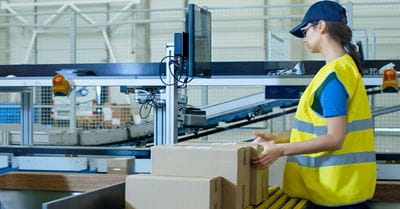Seamless Integration of Small Parcel Solutions into Modern Operations

Small parcel automation is transforming e-commerce warehouses by integrating packing, labeling, document insertion, and sortation systems for greater efficiency and accuracy. Leveraging real-time data and AI-driven solutions, these technologies reduce errors, optimize costs, and enhance the speed of order fulfillment.
In the whirlwind of e-commerce growth, where a single warehouse might dispatch thousands of packages daily, the margin for inefficiency is very slim. Missed delivery windows, mislabeled boxes, or misplaced invoices no longer merely frustrate customers, they erode brand loyalty and profitability. Integrating small parcel automation into existing workflows isn’t just about keeping pace; it’s about reimagining how precision and speed can coexist in high-volume environments. Imagine a warehouse where boxes materialize in perfect sizes, cushioning molds to each product’s contours, and tape secures seams with robotic precision. Modern packing systems achieve this by marrying real-time data with mechanical agility. Dimensioning technologies scan items to calculate optimal box sizes, reducing wasted space and minimizing dimensional weight charges, a critical factor in freight costs. For fragile goods, automated void-fill systems adjust cushioning levels based on item weight and fragility, replacing the inconsistent handiwork of overburdened staff. The true power lies in integration. When packing stations sync with warehouse management systems (WMS), they pull order data to pre-configure materials (think custom-printed marketing inserts for loyal customers or region-specific compliance labels). This connectivity slashes the cognitive load on workers, who no longer juggle tape guns while deciphering pick lists. The result? A potential 30–50% reduction in packing time and a 20% drop in material costs. A package’s contents might win customer hearts, but its paperwork safeguards the transaction. Invoices, return slips, and safety sheets aren’t mere paper, they’re legal safeguards and brand ambassadors. Manual insertion, however, introduces risks: a skipped page during peak hours, coffee stains on promotional flyers, or misaligned barcodes. Automated document insertion systems act as meticulous librarians, ensuring every envelope or carton receives precise documentation. Advanced systems fold, sort, and insert multi-page packets at speeds exceeding 200 documents per minute, synchronized to conveyor belt movements. Optical sensors verify each document’s presence and orientation, while integration with enterprise resource planning (ERP) platforms enables last-minute updates like adding a recall notice or holiday coupon. For global shipments, these systems toggle between languages and regulatory requirements, ensuring compliance without manual oversight. The payoff? A 99.8% accuracy rate in document inclusion, virtually eliminating customer service disputes over missing paperwork. A shipping label is more than an address, it’s a package’s digital fingerprint. Automated print-and-apply systems etch this identity with laser focus. Weigh-in-motion sensors trigger label printers the millisecond a package enters the station, while synchronized applicators adhere tags at precise angles to survive rough handling. For irregularly shaped items, robotic arms maneuver around edges, avoiding seams where labels might peel. These systems shine in complex environments. Consider a batch of 500 parcels destined for 20 countries: automated rate shopping compares carrier costs in real time, selects optimal services, and prints compliant labels with harmonized system codes, all before a human registers the order. The outcome? A potential 40% reduction in shipping errors and a 15% decrease in carrier expenses, achieved through optimized routing and flawless documentation. In the symphony of logistics, sortation systems are the conductors, directing each parcel to its rightful movement. Modern solutions transcend simple diverters; they’re decision engines. Cross-belt sorters with AI vision identify package dimensions and shapes, adjusting chute angles to gently guide fragile items away from heavy machinery. For facilities handling micro-fulfillment, tilt-tray systems segregate batches into clinic orders, retail replenishment, and direct-to-consumer flows, all while scanning labels to verify destinations. The magic lies in predictive analytics. By analyzing historical data, these systems anticipate bottlenecks and reroute parcels preemptively. During peak seasons, they dynamically allocate resources, prioritizing express shipments without starving standard lanes. Gaining Efficiency Through Automation To remain competitive in e-commerce, automation is not just beneficial, it’s essential. For operations managers, this isn’t about replacing humans but empowering them; automation handles repetitive tasks, freeing staff to resolve exceptions and innovate. Understanding current automation technologies and how to implement them can be an overwhelming task. To learn more about cutting edge small parcel solutions for your business, get in touch with an e-commerce expert at Raymond West Intralogistics Solutions today. The Foundation: Adaptive Packing Solutions
Automated Document Insertion
Intelligent Label Application
Dynamic Sortation Systems

